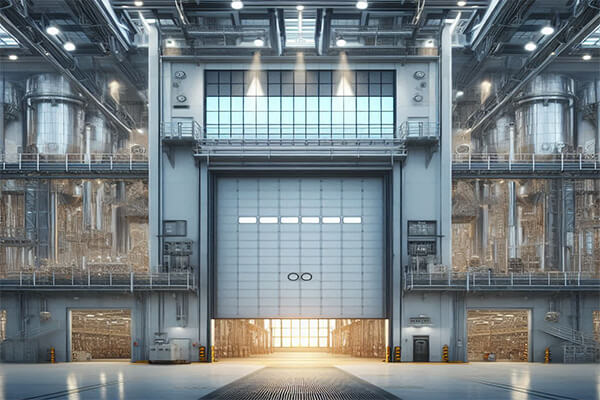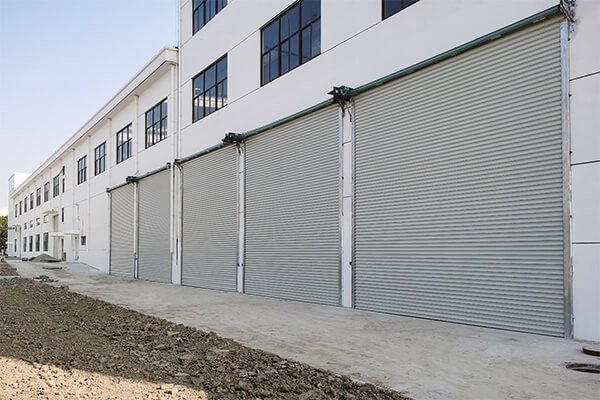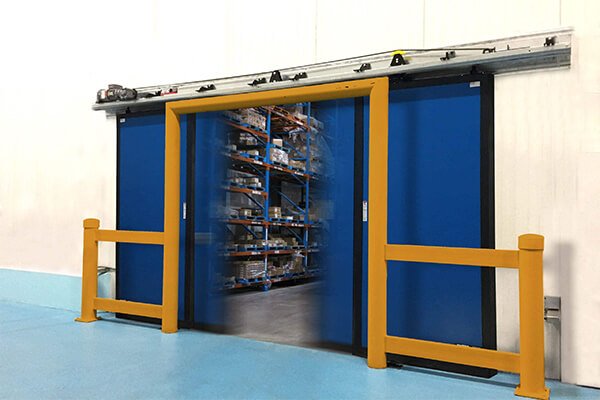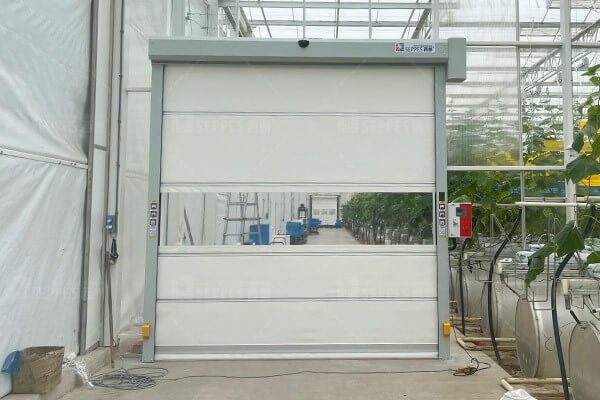
In the vast landscape of industrial facilities, the factory is the heart of production. It is the focal point of innovation and efficiency. Among the many components that ensure the smooth operation of a factory. Factory door plays a vital, yet often overlooked, role. As a gateway between different areas of the factory floor or between the interior and the external environment. These doors make a significant contribution to safety, productivity and energy efficiency.

Development of factory door
With the continuous development of industrialization, the design and application of industrial plant doors are also progressing. Traditional doors can no longer meet the needs of modern industry. Modern industrial plant doors need to pay more attention to the requirements of performance and aesthetics. From the early wood panel doors to today’s automated doors, the design and application of industrial plant doors have received widespread attention. Industrial plant doors play an important role in industrial buildings. They not only need to provide effective access and ventilation, but also meet the requirements of environmental protection and energy saving. Reasonable industrial plant door design and selection will directly affect the industrial production efficiency and product quality.
Factory door selection factors
Industrial door material selection: color steel plate, stainless steel and aluminum alloy and several other materials, according to the actual situation.
The brand of the industrial door: choose a strong brand, you can guarantee the quality of the product and service.
Industrial door materials and accessories: industrial door frame materials generally use carbon steel materials, aluminum alloy materials and so on. Among them, aluminum alloy material is used more. Door plate thickness generally choose 40 or 50 thick plate, so that the use of stability and durability. Pulley generally use plastic pulley, metal pulley and fiberglass pulley. Fiberglass pulley than the other two toughness, wear resistance, smooth sliding, durable, durable.
Safety of industrial doors: the design of industrial doors should take into account their safety. Including fire prevention, anti-theft, explosion-proof and other functions. To ensure the safety of the industrial production process.
Reliability of industrial doors: The design of industrial doors should take into account their reliability, including durability, durability, corrosion resistance and so on. To ensure that the industrial door can operate stably for a long time.
Aesthetics of industrial doors: the design of industrial doors should take into account their aesthetics. Including appearance design, color selection, material selection, etc., to ensure that the industrial door can be coordinated with the surrounding environment.
Practicality of industrial doors: the design of industrial doors should take into account their practicality, including size, weight, opening mode and so on. To ensure that industrial doors can meet the needs of practical application scenarios.
Cost-effectiveness of industrial doors: The design of industrial doors should take into account their cost-effectiveness. This includes material selection, manufacturing process, etc. To ensure that the manufacturing cost of industrial doors is reasonable, and at the same time can meet the needs of customers.
Types of factory doors
Sectional Door
Industrial sectional door consists of a series of door panels (commonly metal or cloth materials, etc.). Rising along the track, industrial sectional door in the appearance of the structural design of the grand, the use of a sense of comfort. The larger size of the industrial products of its stable, spectacular running posture can bring people a strong visual impact. Torsion spring system or counterweight system to ensure the balance of the door body. The different track systems and lifting methods of industrial lifting door panels make it adaptable to different buildings, with a variety of colors to choose from. Its dexterity makes it suitable for almost every kind of door outside the building.

advantages
1.Beautiful appearance, the appearance of the design in line with modern industrial aesthetics. The color of the door panel ca customized according to Raul color card. Variety of styles to choose from, effectively enhance the corporate grade.
2.Heat preservation and wind resistance, the door panel is filled with polyurethane foam. Thickness 40-80mm, strong thermal insulation ability, can resist about 10 level wind.
3. Good sealing, the door edge adopts EPDM sealing, air tightness and water tightness have reached the international standard. Effectively reduce energy loss, but also block the entry of mosquitoes and dust.
disadvantages
1.Slow opening and closing speed, due to the overall quality and size of the door is on the large side, the lifting speed is slow.
2. Less frequent opening, if too much opening will damage the motor.
Roll Up Door
Roll up doors are composed of rollers, top boxes, guide rails, rack and pinion, and can be divided into manual and electric. Manual rolling doors need to be pulled manually, and electric rolling doors are driven by motors. It is more convenient to open and close the door. Rolling doors are usually made of hard alloy, with anti-corrosion surface treatment, anti-theft, smoke and other functions. In addition, the rolling door is durable. It does not occupy indoor space. It is suitable for the situation that there are cars entering and exiting at the entrance of the plant.

advantages
1.durable, suitable for all weather conditions.
disadvantages
1.Relatively slow to open, not suitable for wide entrances.
Industrial Sliding Door
Industrial sliding door is one of the industrial doors, it is a single or multiple door body. Along the designated track phase door opening side or both sides of the movement. Realize the opening and closing of a door type, its running track for linear displacement, also known as the sliding door. It is one of the most popular industrial doors for steel structure plants.

advantages
1.Space saving: sliding doors do not need to open inwards or outwards. Therefore, they can save indoor and outdoor space and are suitable for places with limited space.
2.Suitable for larger openings: sliding doors can be designed in larger sizes. Suitable for large openings, such as warehouses and factories.
disadvantages
1.Installation Complexity: Compared to other door types, sliding doors are relatively complex to install. Accurate measurements and installation are required, otherwise the door may not slide easily or be unstable.
2.High maintenance cost: If the sliding system of the sliding door has problems, the repair and replacement cost may be high.
3.Not suitable for frequent opening: sliding doors may be less suitable for places that need to be opened and closed frequently. This is because you need to wait for the door to slide fully open each time you open it.
4.Vulnerable to weather: If installed outdoors, the sliding and sealing elements of a sliding door are susceptible to weather conditions. Such as rain, snow or strong winds, requiring regular maintenance and cleaning.
Spiral Door
Spiral door is also known as Aluminum Alloy High Speed Door. It is a kind of metal industrial door that combines heat preservation, energy saving, sealing, high efficiency, wind resistance and environmental protection. It is an innovative product in the field of industrial technology. This rapid door is not only resistant to strong wind, but also has a high degree of sealing, reliability and practicality. The technology of the Turbo Rigid Rapid Door is at a high level in the field of industrial doors. It guarantees a good seal even in high-pressure working environments. And it can withstand strong winds of more than 11 levels. Its fast opening speed and high security are suitable for frequent and high-speed opening and closing of the logistics channel. Warehouse workshop, cold storage, etc., as well as the need to resist wind insulation of the factory gate, underground garage and other places.

advantages
1.Fast operation: equipped with high-speed servo control motor, speed up to 2 meters per second. It can be adjusted autonomously; it supports high-frequency switching and can work more than 1,500 times a day. Trouble-free operation more than 300,000 times per year.
2.High strength material: inside and outside are selected high quality aluminum profiles. The core is high-density polyurethane foam.
3.Safety settings: the bottom edge is equipped with soft bottom airbag protection. To prevent accidentally smashed into the personnel. Aluminum alloy column is infrared protection device. Sensing in and out of the vehicle personnel, to ensure that the passage of the door body will not fall.
4.Simple operation: the right hand side button control open/close. There is also an emergency stop protection device, easy to learn.
5.Automatic or manual opening: the factory standard is manual button control. You can choose pull rope switch, swipe card access control, remote control opening, geomagnetic coil induction, radar induction.
6.Manual device: In case of emergency power failure, there is a reserve power supply installed inside the electric control. The door body can be lifted up and opened with the help of balancing system. It can effectively solve the problem that the door body can not be opened due to power failure.
disadvantages
1.High installation and maintenance costs: Compared to traditional door types, spiral high speed doors are usually more expensive to install and maintain. This is because they involve special mechanical components and electronic systems.
Advanced Considerations in Factory Door Selection
Customization and Adaptability
Each plant has unique requirements dictated by its specific operations, layout and environmental conditions. As a result, off-the-shelf solutions may not always be sufficient. When it comes to choosing factory doors, customization options offer tailor-made solutions to meet the different needs of each factory. Whether it’s accommodating oversized machinery, integrating specialized safety features. or with fire-resistant materials, customized doors are versatile and adaptable to meet changing industrial needs.
Temperature control and Environmental
In industries such as food processing, pharmaceutical and electronics manufacturing. Maintaining optimal temperature and environmental conditions is critical. Factory doors with insulating properties help regulate interior temperatures and prevent heat loss in cold environments. Minimize heat gain in hot climates. In addition, an airlock system of interlocking doors ensures that air exchange between the controlled environment and the outside atmosphere is minimized. This maintains product integrity and compliance with regulatory standards.
Future Trends in factory Door Technology
Emerging trends include the integration of smart technology for real-time monitoring and control, sustainable materials, and designs focused on energy efficiency and enhanced safety.
Supplier Selection
The choice of supplier is as important as the factory door itself. Look for suppliers with a proven track record, comprehensive service offerings, and the ability to provide customized solutions.Such as Seppes、hoermann、Rite.
Compliance and Certification
Quality Certification: If the factory gate is supplied by another company or manufacturer. It may be necessary to ensure that they comply with quality standards and certifications to ensure reliability and safety for long term use.
International Standard Certification: For certain industries, compliance with specific international standards, such as ISO certification, may be required. To prove that the quality management system of the factory gate meets international standards.
Installation and Maintenance of factory door
Regular inspection and cleaning: Regularly inspect all parts of your gate. This includes the door track, door leaf, drive system, sensors, etc. to ensure that they are not damaged or have debris buildup. Clean the surface and interior of the gate, especially in dusty or contaminated environments. Regular cleaning will extend the life of the gate.
Lubrication and Adjustment: All moving parts should be lubricated regularly to minimize friction and wear. At the same time, make sure that all parts of the door are adjusted to the correct position and angle to ensure smooth operation. Adjustment of the door track is particularly important, as any deviation can cause the door to jam or become unstable.
Sensor and Control System Checks: If the factory door equip with automation systems, sensors or control panels. It is vital to check their working condition on a regular basis. Ensure that the sensors are properly sensitized and the control system is functioning properly to avoid malfunctioning.
Fasteners and Connectors Check: Regularly check all fasteners and connectors, including screws, nuts, bolts, etc. Make sure they are tight and secure. Make sure they are tightened securely and are not loose or damaged. Loose connections may cause the door to become unstable or deflected, thus affecting the operation of the door.
Record and Plan Maintenance: Create a maintenance record and develop a maintenance plan to record when, what and who did each maintenance. Establish a regular maintenance schedule. According to the frequency of use of the gate and environmental conditions, carry out preventive maintenance at the right time. Prevent future failures and damage.
Conclusion
In summary, when choosing factory doors for factories. A combination of safety, efficiency and sustainability factors need to consider. Firstly, ensure that the factory door has good protection and safety features to keep employees and equipment safe. Secondly, choose doors that open quickly, adapt to different needs and are energy efficient to improve efficiency and reduce energy costs. Finally, prioritize doors that materials are sustainable materials, are durable and easy to maintain to reduce your environmental impact and extend the life of your doors. Consider all of these factors. You’ll be able to choose the door that best suits your plant’s needs, ensuring that it operates safely, efficiently and in line with sustainability goals.
Frequently Asked Questions (FAQs)
1.How do I choose the right factory door for my facility?
Consider factors such as the size of the opening, the type of traffic (pedestrian or vehicular), environmental conditions (temperature, humidity, etc.), security requirements, and any industry-specific regulations or standards that need to be met.
2.Do factory doors require regular maintenance?
Yes, like any other mechanical equipment, factory doors benefit from regular inspection and maintenance to ensure optimal performance and longevity. This may include lubrication of moving parts, inspection of sensors and safety features, and periodic adjustments.
3.Are factory doors compliant with industry standards and regulations?
Reputable manufacturers design factory doors to meet or exceed industry standards and regulations, such as ANSI (American National Standards Institute), UL (Underwriters Laboratories), NFPA (National Fire Protection Association), and OSHA (Occupational Safety and Health Administration) requirements.
4.Can factory doors fit unique requirements?
Yes, many manufacturers offer customization options to tailor factory doors to specific dimensions, materials, insulation levels, security features, and aesthetic preferences. This ensures that the door solution meets the unique needs of each facility.
5.Can factory doors be integrated with access control systems?
Yes, factory doors can be integrated with various access control systems, including keypads, card readers, biometric scanners, and remote control devices. This enhances security by restricting access to authorized personnel and monitoring entry and exit activity.





















